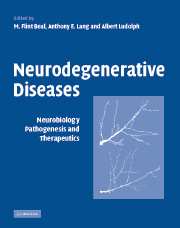Book contents
- Frontmatter
- Contents
- List of contributors
- Preface
- Part I Basic aspects of neurodegeneration
- Part II Neuroimaging in neurodegeneration
- Part III Therapeutic approaches in neurodegeneration
- Normal aging
- Part IV Alzheimer's disease
- Part VI Other Dementias
- Part VII Parkinson's and related movement disorders
- 37 Approach to the patient presenting with parkinsonism
- 38 Parkinson's disease
- 39 Neuropathology of Parkinson's disease
- 40 Genetics of parkinsonism
- 41 Pathophysiology: biochemistry of Parkinson's disease
- 42 Current and potential treatments of Parkinson's disease
- 43 Multiple system atrophy
- 44 Progressive supranuclear palsy
- 45 Corticobasal degeneration
- Part VIII Cerebellar degenerations
- Part IX Motor neuron diseases
- Part X Other neurodegenerative diseases
- Index
- References
43 - Multiple system atrophy
from Part VII - Parkinson's and related movement disorders
Published online by Cambridge University Press: 04 August 2010
- Frontmatter
- Contents
- List of contributors
- Preface
- Part I Basic aspects of neurodegeneration
- Part II Neuroimaging in neurodegeneration
- Part III Therapeutic approaches in neurodegeneration
- Normal aging
- Part IV Alzheimer's disease
- Part VI Other Dementias
- Part VII Parkinson's and related movement disorders
- 37 Approach to the patient presenting with parkinsonism
- 38 Parkinson's disease
- 39 Neuropathology of Parkinson's disease
- 40 Genetics of parkinsonism
- 41 Pathophysiology: biochemistry of Parkinson's disease
- 42 Current and potential treatments of Parkinson's disease
- 43 Multiple system atrophy
- 44 Progressive supranuclear palsy
- 45 Corticobasal degeneration
- Part VIII Cerebellar degenerations
- Part IX Motor neuron diseases
- Part X Other neurodegenerative diseases
- Index
- References
Summary
Historical review
The term multiple system atrophy (MSA) was introduced by Graham and Oppenheimer in 1969 to denote a neurodegenerative disease characterized clinically by various combinations of autonomic, parkinsonian, cerebellar or pyramidal symptoms and signs and pathologically by cell loss and gliosis in some or all of the following structures: putamen, caudate nucleus, globus pallidus, substantia nigra, locus ceruleus, inferior olives, pontine nuclei, cerebellar Purkinje cells, intermediolateral cell columns and Onuf's nucleus of the spinal cord.
Previously, cases of MSA were reported under the rubrics of olivopontocerebellar atrophy (OPCA), idiopathic orthostatic hypotension (IOH) or progressive autonomic failure (PAF), Shy–Drager syndrome (SDS) and striatonigral degeneration (SND). Although Dejerine and Thomas were the first to introduce the term OPCA in 1900 reporting two sporadic cases of late-onset ataxia, the case of Stauffenberg in 1918, diagnosed in life as OPCA, was the first to associate cerebellar, parkinsonian and autonomic features with identified pathological lesions not only of olives, pons and cerebellum, but also of basal ganglia pigmentation and atrophy of putamen, with additional cell loss in caudate and globus pallidus (Quinn, 1994).
The term SND was introduced in 1960 by van der Eecken, Adams and van Bogaert (van der Eecken et al., 1960; Adams et al., 1961, 1964) who noted pronounced shrinkage and brownish discoloration of the putamen and pallidum as well as depigmentation of the substantia nigra in three patients with progressive and severe parkinsonism associated with cerebellar, pyramidal and autonomic features.
- Type
- Chapter
- Information
- Neurodegenerative DiseasesNeurobiology, Pathogenesis and Therapeutics, pp. 623 - 662Publisher: Cambridge University PressPrint publication year: 2005
References
- 2
- Cited by

